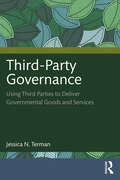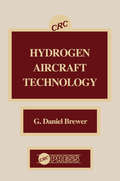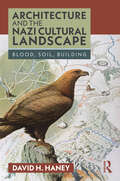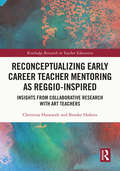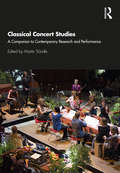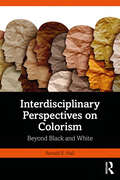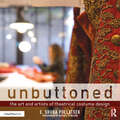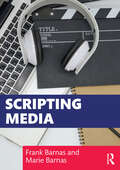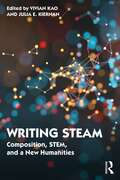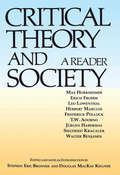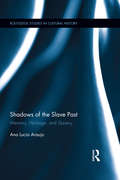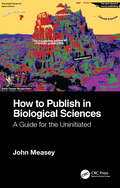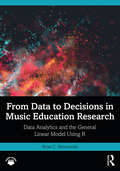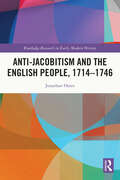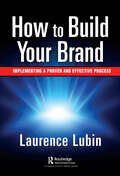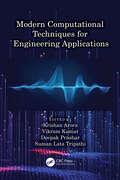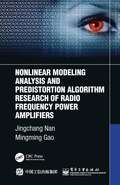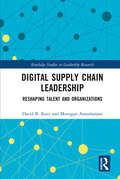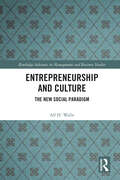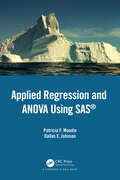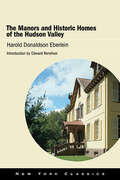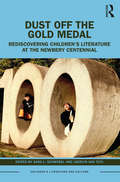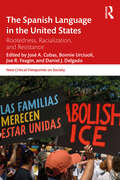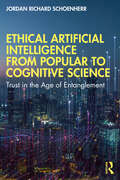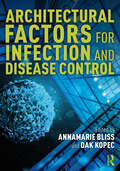- Table View
- List View
Third-Party Governance: Using Third Parties to Deliver Governmental Goods and Services
by Jessica N. TermanEvery year thousands of college students apply for and receive federally guaranteed loans to fund their educations in the United States. The loans are managed by nongovernmental entities – Sallie Mae, College Ave Student Loans – that indirectly implement the public goal of affordable higher education. Put another way, the US Department of Education relies on these nongovernmental entities for implementation of public policy via third parties. Where this kind of indirect implementation occurs, and how it differs from direct implementation, is the focus of this book, introducing readers to the theory and practice of third-party governance. It helps students understand market-oriented tools such as contracting, networks, public-private partnerships and other collaborative governance mechanisms that make up the repertoire of third-party governance. This background is, in turn, key to understanding modern governance arrangements all over the world.Author Jessica N. Terman explores the ‘whys’ behind government and the market, alongside the theories behind when one or both should be used. The book is filled with case studies exploring the issues at play in third-party governance, including transaction costs and the practices that mitigate transaction costs, as well as the advent of networks and how they have changed the governance structure of public policy implementation. Taking a jargon-free approach, the book is written as a primer on third-party governance, introducing readers to the ways that government is structured and the factors that influence contemporary policy implementation. Third-Party Governance will be required reading on courses related to public administration, public policy, and governance and collaboration.
Hydrogen Aircraft Technology
by G.Daniel BrewerLiquid hydrogen is shown to be the ideal fuel for civil transport aircraft, as well as for many types of military aircraft. Hydrogen Aircraft Technology discusses the potential of hydrogen for subsonic, supersonic, and hypersonic applications. Designs with sample configurations of aircraft for all three speed categories are presented, in addition to performance comparisons to equivalent designs for aircraft using conventional kerosine-type fuel and configurations for aircraft using liquid methane fuel. Other topics discussed include conceptual designs of the principal elements of fuel containment systems required for cryogenic fuels, operational elements (e.g., pumps, valves, pressure regulators, heat exchangers, lines and fittings), modifications for turbine engines to maximize the benefit of hydrogen, safety aspects compared to kerosine and methane fueled designs, equipment and facility designs for servicing hydrogen-fueled aircraft, production methods for liquid hydrogen, and the environmental advantages for using liquid hydrogen. The book also presents a plan for conducting the necessary development of technology and introducing hydrogen fuel into the worldwide civil air transport industry. Hydrogen Aircraft Technology will provide fascinating reading for anyone interested in aircraft and hydrogen fuel designs.
Architecture and the Nazi Cultural Landscape: Blood, Soil, Building
by David H. HaneyThis book traces cultural landscape as the manifestation of the state and national community under the Nazi regime, and how the Nazi era produced what could be referred to as a totalitarian cultural landscape.For the Nazi regime, cultural landscape was indeed a heritage resource, but it was much more than that: cultural landscape was the nation. The project of Nazi racial purification and cultural renewal demanded the physical reshaping and reconceptualization of the existing environment to create the so-called "new Nazi cultural landscape." One of the most important components of this was a set of monumental sites thought to embody blood and soil beliefs through the harmonious synthesis of architecture and landscape. This special group of "landscape-bound" architectural complexes was interconnected by the new autobahn highway system, itself thought to be a monumental work embedded in nature. Behind this intentionally aestheticized view of the nation as cultural landscape lay the all-pervasive system of deception and violence that characterized the emerging totalitarian state.This is the first historical study to consider the importance of these monumental sites together with the autobahn as evidence of key Nazi cultural and geographic strategies during the pre-war years. This book concludes by examining racial and nationalistic themes underlying cultural landscape concepts today, against this historic background.
Reconceptualizing Early Career Teacher Mentoring as Reggio-Inspired: Insights from Collaborative Research with Art Teachers (Routledge Research in Teacher Education)
by Christina Hanawalt Brooke HofsessReconceptualizing Early Career Teacher Mentoring as Reggio-Inspired presents an innovative approach to early career art teacher mentoring informed by both the philosophy of Reggio Emilia and an ontology of immanence while simultaneously illuminating the experiences of the teacher-participants as co-inquirers within the contemporary milieu of public education in the United States.Readers are invited to travel with a group of teacher educators and early career PK-12 art teachers across a four-year journey to experience the evolving nature of a collaborative inquiry through mentoring-as-research, the Teacher Inquiry Group (TIG). The authors share significant insights regarding what it means to be an early career art teacher––especially in an educational climate steeped in neoliberal agendas, standardization, and accountability––and make potent suggestions for re-visioning entrenched approaches to mentoring and professional learning that better account for the inherent complexities of teaching in schools. Advocating for more complex understandings regarding teacher subjectivity and the contextual forces at work in schools, the authors provoke an expanded vision of how mentoring can be imagined, practiced, and lived in current educational contexts. The authors employ key orientations grounded in the Reggio Emilia philosophy to reimagine an under-researched and undertheorized area of study in art education-––early career teacher mentoring––that has implications for teachers at all levels and across all disciplines. This volume is essential reading for scholars and professionals across the fields of art education, teacher preparation, teacher education, and mentoring. It will appeal to educational researchers, K-12 practitioners, teacher educators, and administrators working with new teachers, as well as those interested in mentoring, Reggio Emilia, professional learning and development, art and aesthetic education, and emergent, process-oriented research methodologies.
Classical Concert Studies: A Companion to Contemporary Research and Performance
by Martin TröndleClassical Concert Studies: A Companion to Contemporary Research and Performance is a landmark publication that maps out a new interdisciplinary field of Concert Studies, offering fresh ways of understanding the classical music concert in the twenty-first century. It brings together essays, research articles, and case studies from scholars and music professionals including musicians, music managers, and concert designers. Gathering both historical and contemporary cases, the contributors draw on approaches from sociology, ethnology, musicology, cultural studies, and other disciplines to create a rich portrait of the classical concert’s past, present, and future.Based on two earlier volumes published in German under the title Das Konzert (The Concert), and with a selection of new chapters written for the English edition, this companion enables students, researchers, and practitioners in the classical and contemporary music fields to understand this emerging field of research, go beyond traditional disciplinary boundaries and methodologies, and spark a renaissance for the classical concert.
Interdisciplinary Perspectives on Colorism: Beyond Black and White
by Ronald E. HallThis timely and unique book explores the concept of colorism, which is discrimination based on the color of a person’s skin, in a world where arguably light skin is privileged over dark, and one’s wealth, health, and opportunities are impacted by skin color, sometimes irrespective of one’s racial background.In the context of our multi-cultural and increasingly global society, and the historical backdrop of slavery, the text takes a unique approach by moving from personal anecdotes to adopting a scientific perspective grounded in empirical evidence. Hall explores how skin color is a more effective framework for examining prejudice and discrimination, as racial identities become increasingly mixed due to inter-racial unions and immigration. He argues that racism as discrimination by race is contrived, polarizing, and non-quantifiable, and that it is often skin color that is used to "identify" race, often inaccurately. With skin color being a visual and physical characteristic, with race-based prejudices attached to it, the author shows how skin color can be a loaded identifier of value and identity. In a world where the objective measure of skin color crosses racial boundaries and where race will become increasingly indiscernible over time, the ultimate aim of this book is to prepare for the social future of mankind that has already begun to take shape. Split into three parts, examining historical, contemporary, and potential future perspectives on colorism, this is fascinating reading for students and academics in psychology, social work, education, criminal justice, and other social sciences. The text will also be useful for providing validation for including colorism into the public domain.
Unbuttoned: The Art and Artists of Theatrical Costume Design
by Shura PollatsekUnbuttoned: The Art and Artists of Theatrical Costume Design documents the creative journey of costume creation from concept to performance. Each chapter provides an overview of the process, including designing and shopping; draping, cutting, dyeing, and painting; and beading, sewing, and creating embellishments and accessories. This book features interviews with practitioners from Broadway and regional theatres to opera and ballet companies, offering valuable insights into the costume design profession. Exceptional behind-the-scenes photography illustrates top costume designers and craftspeople at work, along with gorgeous costumes in progress.
Scripting Media
by Frank Barnas Marie BarnasBringing together professional standards, practices, and jargon from across the industry, Scripting Media provides a complete overview of writing for divergent forms of media.While some forms of media writing have been honed and standardized over generations, others demand new ways of thinking and collaborating. Covering traditional forms of scriptwriting, such as news, advertising, and film scripting, as well as newer and more emerging areas of social media and virtual reality, this book is designed to prepare readers for the varying formats, styles, and techniques specific to each medium. Each chapter contains a list of key terms, an historical overview of the area, and technical specifications for students to be aware of. Exercises, essay prompts, and online links help reinforce students’ knowledge and provide avenues for private study.Written in an accessible and engaging style by two renowned media practitioners, authors, and teachers, Scripting Media is essential reading for students approaching media writing for the first time.
Writing STEAM: Composition, STEM, and a New Humanities
by Vivian KaoThis edited collection positions writing at the center of interdisciplinary higher education, and explores how writing instruction, writing scholarship, and writing program administration bring STEM and the humanities together in meaningful, creative, and beneficial ways.Writing professionals are at the forefront of a cross-pollination between STEM (Science, Technology, Engineering, and Mathematics) and the arts and humanities. In their work as educators, scholars, and administrators, they collaborate with colleagues in engineering, scientific, technical, and health disciplines, offer new degree programs that allow students to bring the humanities to bear on design experiments, and build an academic culture that promotes a vision of the humanities in the twenty-first century, as well as a vision of technology that is decidedly human. This collection surveys and promotes that work through chapters focused on writing instruction, writing scholarship, and writing program administration, covering topics that include data-driven writing courses, public science communication, non-traditional college students, creative writing, gamification, skills transfer, and Writing Across the Curriculum programs. Writing STEAM will be essential reading for scholars, instructors, and administrators in writing studies, rhetoric and composition, STEM, and a variety of interdisciplinary programs; it will aid in teacher training for both humanities and STEM courses focused on writing and communication.
Critical Theory and Society: A Reader
by Stephen Eric BronnerA collection of seminal essays, many appearing in English for the first time, which provides an excellent overview of the critical theory developed by the Frankfurt School.
Shadows of the Slave Past: Memory, Heritage, and Slavery (Routledge Studies in Cultural History)
by Ana Lucia AraujoThis book is a transnational and comparative study examining the processes that led to the memorialization of slavery and the Atlantic slave trade in the second half of the twentieth century. Araujo explores numerous kinds of initiatives such as monuments, memorials, and museums as well as heritage sites. By connecting different projects developed in various countries and urban centers in Europe, Africa, and the Americas during the last two decades, the author retraces the various stages of the Atlantic slave trade and slavery including the enslavement in Africa, the process of confinement in slave depots, the Middle Passage, the arrival in the Americas, the daily life of forced labor, until the fight for emancipation and the abolition of slavery. Relying on a multitude of examples from the United States, Brazil, and the Caribbean, the book discusses how different groups and social actors have competed to occupy the public arena by associating the slave past with other human atrocities, especially the Holocaust. Araujo explores how the populations of African descent, white elites, and national governments, very often carrying particular political agendas, appropriated the slave past by fighting to make it visible or conceal it in the public space of former slave societies.
How to Publish in Biological Sciences: A Guide for the Uninitiated
by John MeaseyThis book is a guide specifically for Early Career Researchers on how to publish in the Biological Sciences, whether that be your first manuscript or if you’re already experienced – there’s something for everyone.Following on from How to Write a PhD in Biological Sciences: A Guide for the Uninitiated, it will guide you through taking your manuscript to publication in peer-reviewed journals and disseminating your research more broadly. It talks you through the peer-review process, including how to respond to reviewers’ comments, the meaning and importance of Impact Factors and how to get citations. It also explores the challenges in the academic community around Open Access and other debates, including transparency, overlay journals, paywalls, publication bias, predatory journals and the dangers of bullying.Whether you are a student just completing your studies, or a supervisor struggling with rejections, this book will provide the insider information you need to get ahead.
From Data to Decisions in Music Education Research: Data Analytics and the General Linear Model Using R
by Brian C. WesolowskiFrom Data to Decisions in Music Education Research provides a structured and hands-on approach to working with empirical data in the context of music education research. Using step-by-step tutorials with in-depth examples of music education data, this book draws upon concepts in data science and statistics to provide a comprehensive framework for working with a variety of data and solving data-driven problems.All of the skills presented here use the R programming language, a free, open-source statistical computing and graphics environment. Using R enables readers to refine their computational thinking abilities and data literacy skills while facilitating reproducibility, replication, and transparency of data analysis in the field. The book offers: A clear and comprehensive framework for thinking about data analysis processes in a music education context. An overview of common data structures and data types used in statistical programming and data analytics. Techniques for cleaning, preprocessing, manipulating, aggregating, and mining data in ways that facilitate organization and interpretation. Methods for summarizing and visualizing data to help identify structures, patterns, and trends within data sets. Detailed applications of descriptive, diagnostic, and predictive analytics processes. Step-by-step code for all concepts and analyses. Direct access to all data sets and R script files through the accompanying eResource. From Data to Decisions in Music Education Research offers a reference "cookbook" of code and programming recipes written with the graduate music education student in mind and breaks down data analysis processes and skills in an approachable fashion. It can be used across a wide range of graduate music education courses that rely on the application of empirical data analyses and will be useful to all music education scholars and professionals seeking to enhance their use of quantitative data.
Anti-Jacobitism and the English People, 1714–1746 (Routledge Research in Early Modern History)
by Jonathan OatesIn both 1715 and 1745 there was a major military challenge in Britain to the thrones of George I and George II, posed by Jacobite supporters of the exiled Stuart claimant. This book examines the responses of those loyal to the Hanoverian dynasty, whose efforts have been ignored or disparaged compared to the military perspective or that of the Jacobites.These efforts included those of the clergy who gave loyalist sermons, accompanied the volunteer forces against the Jacobites and even stood up to the Jacobite forces in person. The lords lieutenant organized militia and volunteer forces to support the status quo. Official bodies, such as the corporations, parishes, quarter sessions and sheriffs, organized events to celebrate loyalist occasions and dealt with local Jacobite sympathisers. The press, both national and regional, was uniformly loyal. Finally, both the middling and common people acted, often violently, against those thought to be hostile towards the status quo. The effectiveness of these bodies had limits, but was at times decisive, and showed that the dynasty was not without popular support in its hours of crisis.This volume is essential reading for all those interested in the Jacobite rebellions and the early English Georgian state, church and society.
How to Build Your Brand: Implementing a Proven and Effective Process
by Laurence LubinBrand Strategy is the most important marketing talent. A 2020 Gartner Survey of 400 CMO's cited Brand Strategy as the most needed skill, more valuable than analytics, UX, digital commerce. Previous books on the subject analyze the qualities and characteristics of well-regarded brands. What these books don't offer are the "how to's" of branding. This book empowers readers by teaching them the author's unique, time-tested Success Model, and step-by-step, repeatable method for successful brand building. After reading this insightful book, you will learn how to: Develop "big picture" insight that inspires big brand ideas Use imagery to understand the fundamental human values that give our life meaning as well as learn about the feelings that reveal our hopes and dreams. Develop highly motivating brand concepts that link to our values and aspirations. Create the tactical roadmap to implement the concepts. The author clearly shares the: Success Model that defines the world's most successful brands. Case studies that demonstrate the Model in action.Step-by-step method to implement the model. The evidence -- scientific and psychological --.that supports the model and method. Essentially, this book empowers readers to become skilled brand builders enabling them to succeed personally, socially, and professionally.For more information on this book, please visit: www.howtobuildyourbrand.net
Modern Computational Techniques for Engineering Applications
by Krishan Arora Vikram Kumar Deepak Prashar Suman Lata TripathiModern Computational Techniques for Engineering Applications presents recent computational techniques used in the advancement of modern grids with the integration of non-conventional energy sources like wind and solar energy. It covers data analytics tools for smart cities, smart towns, and smart computing for sustainable development.This book- Discusses the importance of renewable energy source applications wind turbines and solar panels for electrical grids. Presents optimization-based computing techniques like fuzzy logic, neural networks, and genetic algorithms that enhance the computational speed. Showcases cloud computing tools and methodologies such as cybersecurity testbeds and data security for better accuracy of data. Covers novel concepts on artificial neural networks, fuzzy systems, machine learning, and artificial intelligence techniques. Highlights application-based case studies including cloud computing, optimization methods, and the Industrial Internet of Things. The book comprehensively introduces modern computational techniques, starting from basic tools to highly advanced procedures, and their applications. It further highlights artificial neural networks, fuzzy systems, machine learning, and artificial intelligence techniques and how they form the basis for algorithms. It presents application-based case studies on cloud computing, optimization methods, blockchain technology, fog and edge computing, and the Industrial Internet of Things. It will be a valuable resource for senior undergraduates, graduate students, and academic researchers in diverse fields, including electrical engineering, electronics and communications engineering, and computer engineering.
Nonlinear Modeling Analysis and Predistortion Algorithm Research of Radio Frequency Power Amplifiers
by Jingchang Nan Mingming GaoThis book is a summary of a series of achievements made by the authors and colleagues in the areas of radio frequency power amplifier modeling (including neural Volterra series modeling, neural network modeling, X-parameter modeling), nonlinear analysis methods, and power amplifier predistortion technology over the past 10 years. The book is organized into ten chapters, which respectively describe an overview of research of power amplifier behavioral models and predistortion technology, nonlinear characteristics of power amplifiers, power amplifier behavioral models and the basis of nonlinear analysis, an overview of power amplifier predistortion, Volterra series modeling of power amplifiers, power amplifier modeling based on neural networks, power amplifier modeling with X-parameters, the modeling of other power amplifiers, nonlinear circuit analysis methods, and predistortion algorithms and applications.Blending theory with analysis, this book will provide researchers and RF/microwave engineering students with a valuable resource.
Digital Supply Chain Leadership: Reshaping Talent and Organizations (Routledge Studies in Leadership Research)
by David Kurz Murugan AnandarajanStrong leadership is necessary to drive the transformational change required to build and apply digital capabilities across organizations. Digital transformation in the supply chain is a leadership problem first and foremost. This book draws out some of the key digital business strategies supply chain leaders must become familiar with as they take on the responsibilities of leading transformations within their firms.The central rationale of the book is to establish a clear business case for the performance shifts and opportunities of the Digital Supply Chain. The benefits of a digital supply chain for firms can be summarized as uniquely reducing the amount of trade-off between costs and customer satisfaction. The challenges, complexity, and management involved in transforming to a digital supply chain have slowed many firms in their implementation. The key to unlocking this value and advantage is a new, robust, and digitally aware supply chain leadership mindset. It will provide readers with a practical Digital Supply Chain Leadership Road Map that will accelerate actions in technology, analytics, talent and business models. The road map to digital transformation will step the reader through these critical dimensions and illustrate how they can support their own organizational transformation by developing greater levels of maturity. This book will be most valued by supply chain leaders in medium to large scale organizations, as well as consultants and academics interested in digital business and supply chain transformation. The book will also be valuable for students studying digital transformation, supply chain, and operations.
Entrepreneurship and Culture: The New Social Paradigm (ISSN)
by Alf H. WalleThe classic and dominant paradigm of entrepreneurship emphasizes the relatively universal and homogeneous responses of a small, but influential, minority as they make unique and breakthrough contributions. Entrepreneurs are often viewed as inspired individualists who possess the courage to "go against the grain" as they risk it all to pursue an impassioned vision. According to Joseph Schumpeter and those who build upon his seminal perspectives, such entrepreneurial individuals pursue a path of "creative destruction" that paves the way towards true and innovative progress. Today, state of the art research is tempering and transcending this classic vision by acknowledging a wider array of cultural, psychological, and environmental contexts, influences, and responses. This monograph contributes to this research stream by viewing entrepreneurs within a cultural perspective and advocating viewing entrepreneurship in "culturally competent" ways. Presenting these perspectives in a short and circumscribed volume provides an elegant and influential means of disseminating these important perspectives. Entrepreneurship and Culture expands beyond popular and conventional views of entrepreneurship and provides readers with alternative perspectives in even-handed ways. It shows the latest state of knowledge on the topic and will be of value both to advanced students, and to academics and practitioners in the fields of entrepreneurship, international business, leadership and organizational studies. Beyond the business school, this book will also be of interest to anthropology, economic development, and indigenous studies scholars.
Applied Regression and ANOVA Using SAS
by Patricia F. Moodie Dallas E. JohnsonApplied Regression and ANOVA Using SAS® has been written specifically for non-statisticians and applied statisticians who are primarily interested in what their data are revealing. Interpretation of results are key throughout this intermediate-level applied statistics book. The authors introduce each method by discussing its characteristic features, reasons for its use, and its underlying assumptions. They then guide readers in applying each method by suggesting a step-by-step approach while providing annotated SAS programs to implement these steps.Those unfamiliar with SAS software will find this book helpful as SAS programming basics are covered in the first chapter. Subsequent chapters give programming details on a need-to-know basis. Experienced as well as entry-level SAS users will find the book useful in applying linear regression and ANOVA methods, as explanations of SAS statements and options chosen for specific methods are provided.Features:•Statistical concepts presented in words without matrix algebra and calculus•Numerous SAS programs, including examples which require minimum programming effort to produce high resolution publication-ready graphics•Practical advice on interpreting results in light of relatively recent views on threshold p-values, multiple testing, simultaneous confidence intervals, confounding adjustment, bootstrapping, and predictor variable selection•Suggestions of alternative approaches when a method’s ideal inference conditions are unreasonable for one’s dataThis book is invaluable for non-statisticians and applied statisticians who analyze and interpret real-world data. It could be used in a graduate level course for non-statistical disciplines as well as in an applied undergraduate course in statistics or biostatistics.
The Manors and Historic Homes of the Hudson Valley (New York Classics)
by Harold Donaldson EberleinHarold Donaldson Eberlein's The Manors and Historic Homes of the Hudson Valley has been considered an essential and elegant resource ever since its first publication by J.B. Lippincott in 1924. Profusely illustrated with drawings, classic prints, and photographs (many of the latter taken by the author himself), the book not only discusses the architecture and beauty of more than thirty-five historically relevant estates and homesteads, but also contextualizes their varied histories amid key social and political disruptions, ranging from the rise of the Dutch through to the American Revolution and the heyday of the patroonships overseen by such families as the Livingstons, the Van Rensselaers, and the Van Cortlandts. Eberlein saw the old manors and historic homes of the Hudson Valley as vital signposts to that history of the region— a history "inseparably bound up with the old houses that stand upon both banks of the river, and [a history which] without them … would lose its dramatic force and become a dull, dead abstraction." This new edition features an introduction by historian Ed Renehan who sets the work in the context of its time, and many new photographs. This book is an indispensable resources for those interested in New York state history and the stories behind some of its best-loved homes.
Dust Off the Gold Medal: Rediscovering Children’s Literature at the Newbery Centennial (Children's Literature and Culture)
by Sara L. SchwebelThe oldest and most prestigious children’s literature award, the Newbery Medal has since 1922 been granted annually by the American Library Association to the children’s book it deems "most distinguished." Medal books enjoy an outsized influence on American children’s literature, figuring perennially on publishers’ lists, on library and bookstore shelves, and in school curricula. As such, they offer a compelling window into the history of US children’s literature and publishing, as well as into changing societal attitudes about which books are "best" for America’s schoolchildren. Yet literary scholars have disproportionately ignored the Medal winners in their research. This volume provides a critically- and historically-grounded scholarly analysis of representative but understudied Newbery Medal books from the 1920s through the 2010s, interrogating the disjunction between the books’ omnipresence and influence, on the one hand, and the critical silence surrounding them, on the other. Dust Off the Gold Medal makes a case for closing these scholarly gaps by revealing neglected texts’ insights into the politics of children’s literature prizing and by demonstrating how neglected titles illuminate critical debates currently central to the field of children’s literature. In particular, the essays shed light on the hidden elements of diversity apparent in the neglected Newbery canon while illustrating how the books respond—sometimes in quite subtle ways—to contemporaneous concerns around race, class, gender, disability, nationalism, and globalism.
The Spanish Language in the United States: Rootedness, Racialization, and Resistance (New Critical Viewpoints on Society)
by José A. CobasThe Spanish Language in the United States addresses the rootedness of Spanish in the United States, its racialization, and Spanish speakers’ resistance against racialization. This novel approach challenges the "foreigner" status of Spanish and shows that racialization victims do not take their oppression meekly. It traces the rootedness of Spanish since the 1500s, when the Spanish empire began the settlement of the new land, till today, when 39 million U.S. Latinos speak Spanish at home. Authors show how whites categorize Spanish speaking in ways that denigrate the non-standard language habits of Spanish speakers—including in schools—highlighting ways of overcoming racism.
Ethical Artificial Intelligence from Popular to Cognitive Science: Trust in the Age of Entanglement
by Jordan Richard SchoenherrThis book offers a unique interdisciplinary perspective on the ethics of 'artificial intelligence' – autonomous, intelligent, (and connected) systems, or AISs, applying principles of social cognition to understand the social and ethical issues associated with the creation, adoption, and implementation of AISs.As humans become entangled in sociotechnical systems defined by human and artificial agents, there is a pressing need to understand how trust is created, used, and abused. Compounding the difficulty in answering these questions, stakeholders directly or indirectly affected by these systems differ in their motivations, understanding, and values. This volume provides a comprehensive resource to help stakeholders understand ethical issues of designing and implementing AISs using an ethical sensemaking approach. Starting with the general technical affordances of AIS, Dr. Jordan Richard Schoenherr considers the features of system design relating data integrity, selection and interpretation of algorithms, and the evolution processes that drive AISs innovation as a sociotechnological system. The poles of technophobia (algorithmic aversion) and technophilia (algorithmic preference) in the public perception of AISs are then described and considered against existing evidence, including issues ranging from the displacement and re-education needs of the human workforce, the impact of use of technology on interpersonal accord, and surveillance and cybersecurity. Ethical frameworks that provide tools for evaluating the values and outcomes of AISs are then reviewed, and how they can be aligned with ethical sensemaking processes identified by psychological science is explored. Finally, these disparate threads are brought together in a design framework.Also including sections on policies and guideline, gaming and social media, and Eastern philosophical frameworks, this is fascinating reading for students and academics in psychology, computer science, philosophy, and related areas, as well as professionals such as policy makers and those working with AI systems.
Architectural Factors for Infection and Disease Control
by AnnaMarie Bliss Dak KopecThis edited collection explores disease transmission and the ways that the designed environment has promoted or limited its spread. It discusses the many design factors that can be used for infection and disease control through lenses of history, public health, building technology, design, and education.This book calls on designers to consider the role of the built environment as the primary source of bacterial, viral, and fungal transfers through fomites, ventilation systems, and overcrowding and spatial organization. Through 19 original contributions, it provides an array of perspectives to understand how the designed environment may offer a reprieve from disease. The authors build a historical foundation of infection and disease, using examples ranging from lazarettos to leprosy centers to show how the ability to control infection and disease has long been a concern for humanity. The book goes on to discuss disease propagation, putting forth a variety of ideas to control the transmission of pathogens, including environmental design strategies, pedestrian dynamics, and open space. Its final chapters serve as a prospective way forward, focusing on COVID-19 and the built environment in a post-pandemic world.Written for students and academics of architecture, design, and urban planning, this book ignites creative action on the ways to design our built environment differently and more holistically.Please note that research on COVID-19 has exponentially grown since this volume was written in October 2020. References cited reflect the evolving nature of research studies at that time.
